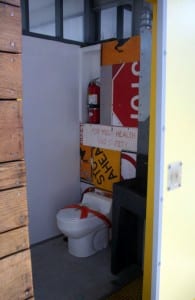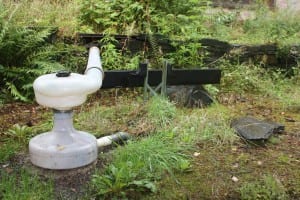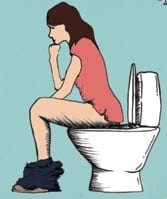Composting Toilets and the Coast Guard: an unlikely love story
By ucft590, on 10 September 2013
The hull of a steel deck barge is one of the last places I would like to be in the sweltering August heat in Virginia. Yet this is where I found myself during the summer of 2009 while I installed the below-deck components for the vessel’s two composting toilets. The barge was not yet in the water, perched on steel beams alongside the shipyard’s waterfront construction area, so I thankfully didn’t have to contend with the water’s movement. However, it wasn’t the most ideal of building situations. Getting to the underside of each toilet was an adventure in itself: I had to crawl into the hull through one of the top deck hatches then navigate through the maze of steel frames that formed the structure of the barge. Since there was a temperature difference between the interior of the hull and the warm, humid exterior air, beads of condensation continually formed within the hull. Working inside the cramped and dark compartments, illuminated only by my LED headlamp, I felt like I was spelunking in a futuristic cave.
As the Project Manager for a sustainable, floating classroom and field station called the Learning Barge, I found myself in some unusual and wholly unimagined situations during the design/build process from 2007 through the vessel’s first operation season in 2010. The Barge was conceived as a demonstration tool for non-profit The Elizabeth River Project, to educate students and adults about their local watershed along the Elizabeth River, one of the most polluted tributaries of the Chesapeake Bay. It showcased a wide range of recycled products (reclaimed road signs were used as cladding), sustainable strategies (a rainwater collection feeds a bio-filtration station), and renewable energy systems (wind turbines and photovoltaic panels provide power). Since we wanted to feature a number of green technologies, the integration of composting toilets was essential for the Barge’s “head” (the name for a toilet on a boat, traditionally named since they were located at the head of the vessel so that passing waves could clean the drainage pits). Although composting toilets are becoming more common for personal watercraft, they are rarely used on commercial or industrial vessels.
Marine toilets are inherently different from their land-based counterparts since they do not have the option of being connected to sewer systems. Therefore most marine sanitation systems are adapted versions of chemical toilets that rely on either a bag system or a ‘pump-out’ for the removal of waste. Neither of these systems are ideal: they utilize toxic chemicals and, until the imposed regulations of the Clean Vessel Act of 1992, it wasn’t uncommon for vessel operators to incorrectly dispose of their waste by simply dumping the chemically-treated contents directly into bodies of water. The toilets of the Learning Barge, two 12VDC Envirolet Waterless Remote Systems, consist of three main elements: a toilet, a composting unit, and a ventilation shaft. The small electrical fans within each of the composting units operate 24 hours a day and 7 days a week, allowing heated air to travel through all six sides of the waste, thereby facilitating rapid evaporation and accelerating the compost process. This is unlike many composting systems, that only have one aeration side (the top). During the regular operational season of the Barge (March –November) the toilets require daily attention: the manual aerator within the composting unit (similar to a rake) needs to be pumped and the blackwater tank needs to be monitored.
With drawings, product documentation, and a detailed operations manual in hand, complete with instructions for what toilet paper to use and procedures for both the start of the season and winterisation, we thought that Coast Guard approval of our composting toilets would be one of the easiest components of the certification process. Yet the uniformed officers were skeptical:
- How could we ensure that the system would work?
- What were we going to do with the waste?
- Would it smell?
The last question was one of the oddest: toilets on ferryboats are rarely pleasant. Over the course of several site visits, we managed to convince the Coast Guard representatives that composting toilets weren’t such a crazy concept for a vessel. We were using a proven supplier, a sturdy unit, and we had outlined every step within the composting process, including specifications for compost disposal in accordance with the Virginia Department of Environmental Quality (a permit was needed for all compost produced outside of residential settings). With questions answered, our vessel received certification in September 2009 and later that autumn, the members of the Coast Guard independently toured the vessel and its sustainable systems as part of a training exercise. Today, in the Code of Federal Regulations for vessels, there are a number of composting toilets approved as Marine Sanitation Devices (MSD).
*Please also donate to UCLoo Festival – just £5 or less will help – to make sure the conversation on ecological urban sanitation happens: http://spacehive.com/ucloofestival2013 But hurry – we must reach our fundraising target by 17th October!
Click here to learn more about the composting toilets used on the Learning Barge:
http://manual.envirolet.info/a/installation-and-operation/envirolet-waterless-remote
Click here to explore the current environmental endeavors of the Learning Barge:
http://www.elizabethriver.org/projects/the_learning_barge.aspx
You can also learn more about the design/build process of the Learning Barge:
http://www.arch.virginia.edu/learningbarge/introduction.html
Toilet stories
By ucessjb, on 3 September 2013
 Families are libraries of embarrassing stories. In my family embarrassing stories are catalogued by theme, as well as person. Embarrassing stories of my youngest sister usually involve overeating, notably of pickled foods. My theme is toilets, or ‘going to the toilet’. Like the time I heard the call of nature whilst climbing a big hill near a busy road with my siblings. From that height everything looked small, and I figured I was invisible to the drivers so far below. When I returned to the car park my grandmother informed me, and countless others in years to come, that I was not. Or my habit of keeping the door open to our semi-outhouse in the small village where I grew up, so I could keep an eye on the infrequent passers-by, mortifying my mother who was more concerned that the whole community could see me. These stories remind me that toilets and ‘going to the toilet’ are meant to be hidden, a lesson I have been very slow to learn.
Families are libraries of embarrassing stories. In my family embarrassing stories are catalogued by theme, as well as person. Embarrassing stories of my youngest sister usually involve overeating, notably of pickled foods. My theme is toilets, or ‘going to the toilet’. Like the time I heard the call of nature whilst climbing a big hill near a busy road with my siblings. From that height everything looked small, and I figured I was invisible to the drivers so far below. When I returned to the car park my grandmother informed me, and countless others in years to come, that I was not. Or my habit of keeping the door open to our semi-outhouse in the small village where I grew up, so I could keep an eye on the infrequent passers-by, mortifying my mother who was more concerned that the whole community could see me. These stories remind me that toilets and ‘going to the toilet’ are meant to be hidden, a lesson I have been very slow to learn.
There are no doubt very good evolutionary, sanitary, psychological and cultural reasons for hiding our toilets and going to the toilet in private. On the other hand, I like to think that outliers like me, who are slow on the uptake of toilet invisibility, serve some sort of social purpose.
We need to go public about toilets. We can no longer hide from the global sanitation crisis. Roughly two and a half billion people don’t have access to any form of improved sanitation. That means that more than one third of the world’s population don’t even have a pit latrine, never mind a flushing toilet. Water resources around the world are increasingly stressed and conventional sewerage infrastructure is expensive to build, maintain and operate.
The flushing toilet and water based sanitation systems that we take for granted in cities like London are unlikely to be replicated in the rapidly urbanising cities of the global south. There are many advantages to flush toilets and water based sewerage systems, but present and future shortages of money, water and nutrients indicate that their costs increasingly outweigh their benefits. It is time for a new model of sanitation, which is more affordable and sustainable.
There are many people around the world working to develop alternative sanitation technologies and systems, particularly to address the global sanitation crisis. The problem is that, by and large, these toilets remain less desirable than the flushing loo. The new model of sanitation needs to desirable.
And so once again I am making myself visible on the toilet. This time I am working with colleagues at UCL to curate a festival of technology and ideas about sanitation. Hosting a toilet festival in London might seem trite, given the scale of the crisis in the global south, and our contribution to solving those vast problems will be minuscule. But our proposition is that the sanitation crisis is truly global. We should all be horrified by the current global shortfall in access to sanitation, and it is wise to be prepared for resource shortages here. If London was the centre of the nineteenth century water based sanitary revolution, then it should also be part of the twenty-first century ecological sanitation revolution. If ecological sanitation is to be affordable, sustainable and desirable, then perhaps it will one day be the preferred option in London. This what we hope to contribute – to make toilets visible and to start a conversation about how we might make ecological sanitation the globally preferred option, not the only option for people who cannot afford any better.
Please donate to UCLoo Festival – just £5 or less will help – to make sure this conversation happens: http://spacehive.com/ucloofestival2013 But hurry – we must reach our fundraising target by 17th October!
The Centre for Alternative Technology
By ucesbar, on 28 August 2013
As part of the preparations for the UCLoo Festival 2013 (19 Nov. – 3 Dec.), the project team spent an afternoon at the Centre for Alternative Technology (CAT) near Machynlleth, Wales (please donate to UCLoo Festival – just £5 or less will help to make sure the conversation on ecological urban sanitation continues: http://spacehive.com/ucloofestival2013 But hurry – we must reach our fundraising total by 17th October!)
The centre is a “living laboratory” for past and present green technologies, exhibiting lower-environmental-impact alternatives for energy, building and plant cultivation.
The centre is also known for its forward-thinking research on ecological sanitation, and we were introduced to four functioning ecological toilets:
1. A low-flush, tiger-worm model developed for Tanzania by Claire Furlong and Walter Gibson at Sanitation Ventures filters toilet liquids through layers of soil and gravel. Worms living in the top layer digest the solid matter, replicating the filtration system of a forest floor.
- Pros: it’s an odourless, attractive, self-contained unit.
- Cons: because the toilet was developed for a warmer climate, it needs lots of insulation to keep the worms warm enough to do their job.
2. The Aquatron, from Sweden, uses a water-efficient (2/4L) system, flushing toilet contents down a pipe into an hourglass-shaped plastic basin that separates the liquids from the poo through gravity-propelled spinning. The solids then fall through a flap into a composting chamber beneath.
- Pros: it’s water-efficient, odourless and looks like a standard toilet.
- Cons: the composting chambers (there are two, allowing each to “rest” for two years before the compost is used) are accessed on an angle and require someone to enter the chamber in order to empty it.
3. NatSol‘s version is a double-chambered composting toilet with a ride-on bench seat, that separates the urine from the faeces, whisking it away down a pipe while the solids fall into the pit below.
- Pros: no water is used, and urine can easily be collected for re-use with a urine-diverting plate.
- Cons: because waste is contained and there is no flush removal system, the toilet smells if it’s not regularly treated with “soak” material (sawdust, straw etc.) to keep it dry.
- Undecided: only sitting is allowed.
4. The Australian-made DOWMUS (Domestic Organic Waste Management Utilisation System), another composting system (installed with an enamel pedestal), is designed to accept all household waste water. However at CAT, a urinal is also provided, to reduce the level of liquid entering the compost pit.
- Pros: smells are removed through a pipe-and-fan system.
- Cons: because the mixture remains wet through the mixing of urine with feces, the toilet container does not compost the matter in the cold Welsh climate, so it fills with raw sewage which must be emptied periodically.
At CAT, faecal waste is composted and used as garden fertilizer once it reaches a safe level of decomposition. Although regulations do not prevent certain uses of nutrient-rich urine in farming, pee at CAT is not currently harvested for use but instead is processed through soak beds, using reeds with nitrogen-rich roots to purify the liquid, which eventually reaches bathing quality.
Our tour guide, Grace Crabb, was very knowledgeable and well-informed, and we hope she’ll visit and perhaps even give a talk at the upcoming UCLoo Festival!
Welcome to UCLoo Festival 2013
By ucesbar, on 30 July 2013
Hello, and welcome to the UCLoo Festival 2013 blog!
The UCLoo Festival 2013 will celebrate the global toilet revolution in the heart of London. More than 2.6 billion people in developing countries do not have access to a safe toilet, and flushing toilets use water, one of our most precious resources, to wash away our dirtiest waste. The world needs a new toilet, and the UCLoo Festival will showcase the latest revolution in public health and sustainability.
As we get closer to the Festival (taking place at UCL Bloomsbury Campus 19th November to 3rd December) we will keep you updated with blog posts from our project team, UCL academics, sanitation experts and all-round toilet enthusiasts.
UCL is a hub for research on water security, environmental governance and sustainable urban design. The project was initiated with support from UCL Engineering, the Bartlett and the Grand Challenge of Sustainable Cities. The UCLoo Festival 2013 will bring awareness of how today’s sanitation systems contribute to London’s water shortage and will highlight the importance of sustainable alternatives.
Keep checking back here for updates, and don’t forget to follow us on Twitter (@UCLooFestival) and like our Facebook page (search for UCLoo Festival). You can also support us via our Spacehive fundraising page! ** URGENT UPDATE: with only one week left to fundraise, we still need to raise 16% of our target! Please give what you can – even £5 or less will help – to make sure this conversation happens: http://spacehive.com/ucloofestival2013 But hurry – we must reach our fundraising total by 17th October!
Thanks and see you soon,
UCLoo Festival project team
 Close
Close










